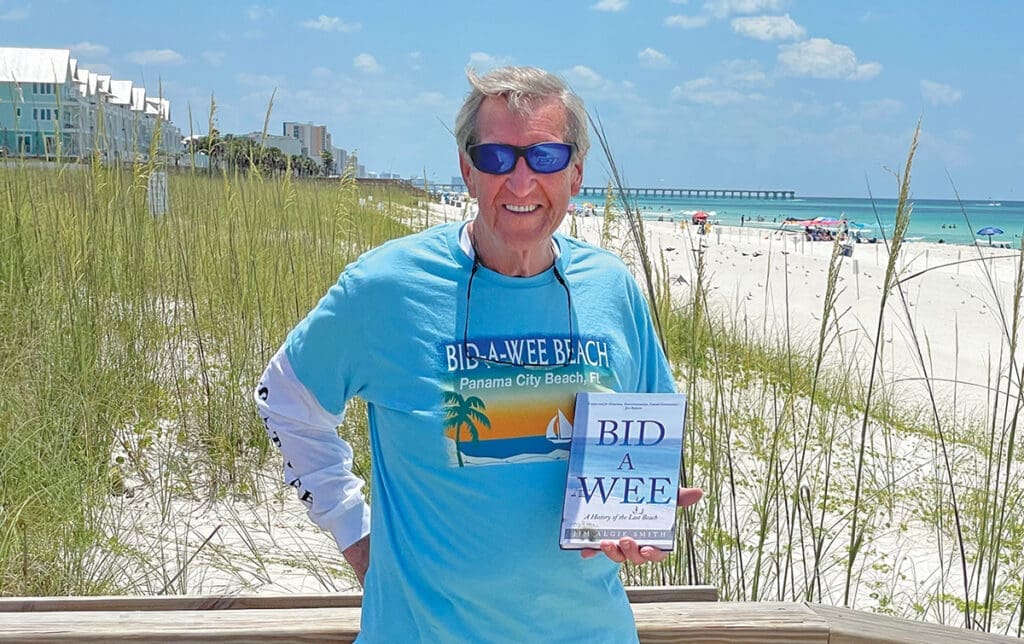By Peter Fischetti
Drive west on Front Beach Road just past Margaritaville and look to the left. History comes alive as you marvel at a half-mile of sand, dunes and foliage, creating a scene that looks pretty much as it did a hundred years ago. Nowhere in Panama City Beach will you find that view as every year condos and hotels hide more and more of the world’s most beautiful beach. So a first-time visitor might wonder, “Why isn’t a Marriott there?”
The answer appears in the just-published book, “Bid-A-Wee: A History of the Last Beach,” written by Jim Smith, who has lived in that community for 30 years. Think of it as a recipe with lots of ingredients from a series of legal skirmishes over ownership of the beach and some unsavory villains to the romance of the couple who first developed the area and a woman whose generous check prevented bankruptcy.
 The book is the result of 10 years of tedious research. “What I found,” Smith said, “was a lot of people from southeast Alabama, southwest Georgia, northwest Florida and the Bid-A-Wee community had a lot to do with the history of Bid-A-Wee Beach.”
The book is the result of 10 years of tedious research. “What I found,” Smith said, “was a lot of people from southeast Alabama, southwest Georgia, northwest Florida and the Bid-A-Wee community had a lot to do with the history of Bid-A-Wee Beach.”
When Smith and his wife, Penny, moved to Bid-A-Wee from Alabama, they learned that the community, including its beach, was owned by a beer distributor in Alabama and that Save-Our-Beach, the organization then representing residents, planned to gain ownership by bidding on the property at a tax-sale auction.
That didn’t make sense to Smith. “I found this to be not only bizarre, but it also just didn’t feel right.” So he decided to do some research. “I became totally immersed in researching the chain of title of the beach including how the beer distributor gained ownership. The research became my passion, and gaining ownership for the community became my cause.”
Some fascinating people surfaced with the research, beginning with Harry Cailey, who purchased the 140 acres that is now Bid-A-Wee in 1926 for under $200 thanks to the Homestead Act. Two years later, the property was sold to Dr. Grover Miller and his wife, Eula, who became the sole owner when her husband died in 1934. She is one of the heroines in the story for developing and ultimately dedicating the beach to property owners in the community.
The story could have ended there, but actually it’s only the beginning. For the rest of the 20th Century and into the 21st, Bid-A-Wee Beach has been a tasty target for individuals, companies, and even our local political leaders to gobble up for their own uses. Each time, the community has prevailed, but sometimes barely. It was, in fact, a day away from a tax-default auction when the story’s second heroine, Eunice Keeton, a Bid-A-Wee property owner, produced a $17,000 check to cover past taxes and other fees.
And even when the dust settled on ownership, Bid-A-Wee faced an internal struggle that included vandalism when coded gates were installed to keep the beach private—and then damage incurred when it was open to the public.
Smith, now 79, served for almost four decades on active duty and in the Reserves in the Army, retiring as a colonel in 2000. He and Penny have two children, and one of them, Lee, and his own two children, convinced him to write this book. While they were enjoying a day on the beach in 2014, Smith asked his grandsons some innocuous questions about Bid-A-Wee when Lee interrupted.
“Dad,” he said, “they know all about this beach and they love it, but what we don’t know about is you and this beach. What happened that made you become so involved with this beach for all those years?”
It’s taken 10 years and about 250 pages, but now they have the answer.
The story will appeal to Bid-A-Wee residents, of course, but anyone interested in the early days of Panama City Beach will find the characters—good and bad—as fascinating as a Grisham novel. And it will make you wish you lived here a hundred years ago and could buy 140 acres of beachfront for under $200.
The book is available in hard-bound, paperback and Kindle at Amazon.com/books. Type Bid-A-Wee, A History of the Last Beach in the search bar.





















































